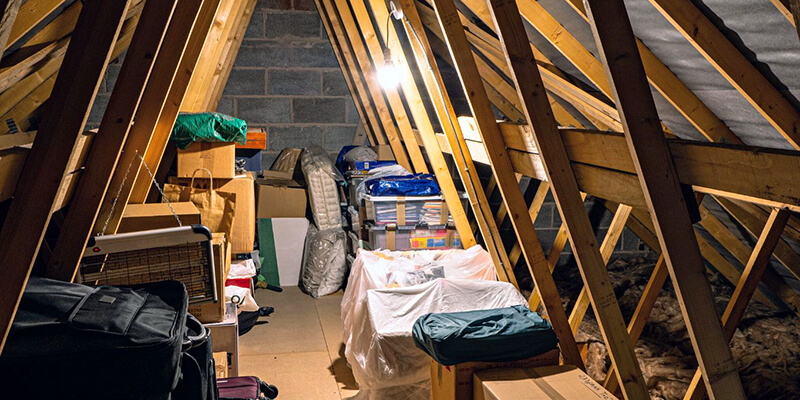Rats in the attic? Not only are they a nuisance, but they can also pose health risks. Let’s explore the best ways to rid your attic of these unwelcome guests.
1. Understand Why They’re There
- Seeking Shelter: Attics offer a cozy, sheltered space away from predators.
- Food Sources: Leftovers, pet food, or even birdseed can attract them.
- Protection: An attic provides a safe haven for breeding.
Knowing their motivations can help target prevention strategies.
2. Seal Entry Points
Before dealing with the rats inside, ensure no more can enter.
- Inspect the Exterior: Check for gaps or holes, especially where eaves meet the roof.
- Repair Damages: Seal any cracks or openings using steel wool or metal flashing. Rats can’t chew through these materials.
- Trim Trees: Ensure tree branches are at least 6 feet away from your home.
3. Use Rat Traps
Traps are a reliable way to deal with a rat problem.
- Snap Traps: Effective and humane if set up correctly.
- Live Traps: Allows for the capture and release of the rat. Ensure you release them at least 5 miles from your home.
- Place them strategically: Near walls and in areas with evidence of rat activity.
4. Baiting: What Works Best
- Peanut Butter: A rat favorite.
- Bacon: Its strong scent is irresistible.
- Fruits: Such as apple slices.
Remember, safety first. Keep baits away from children and pets.
5. Avoid Poison
Though tempting, poisons can:
- Lead to rats dying in hard-to-reach places, causing odor problems.
- Harm non-target animals or pets if ingested.
6. Natural Repellents
These are safer for homes with pets or children.
- Peppermint oil: Rats dislike the strong scent.
- Ammonia: Mimics the scent of a predator’s urine.
- Owl Feathers: Can be placed as a deterrent, as owls are natural rat predators.
7. Clean the Attic
After removal, it’s crucial to:
- Dispose of nests: Wear gloves and a mask.
- Sanitize the area: To remove pheromones that might attract future rats.
- Store items in sealed containers: Cardboard boxes are not rat-proof!
Understanding Rat Behavior
Gaining an insight into why these rodents are making your attic their home can be a game-changer. Rats are intelligent and resourceful creatures.
- Nocturnal Activities: Most rat activities occur during nighttime. So, if you hear rustling or scratching sounds at night, rats could be the culprits.
- Breeding Patterns: A pair of rats can produce as many as 2,000 descendants in a year if left unchecked! This underscores the importance of swift action.
Safety First
Dealing with rats isn’t just about setting traps and baits. You must ensure the safety of your household.
- Wear Gloves: Always use gloves when handling traps or cleaning up after rats. This protects against diseases that rats might carry.
- Dispose of Rats Safely: Once trapped, put the rat in a plastic bag, seal it, and dispose of it in a trash can outside your house.
- Avoid Touching Dead Rats: They can carry diseases. Use tools or protective wear if you must move them.
Keep Them Out For Good
After getting rid of the rats, ensuring they don’t return is equally important.
- Regular Inspections: Set a schedule, perhaps twice a year, to inspect your attic and home’s exterior.
- De-clutter: Rats love hiding spots. The fewer places they have to hide, the less appealing your attic becomes.
- Safe Storage: If storing food in the attic, use sealed metal or thick plastic containers.
Spotting Early Signs
Being proactive is always better than reactive. Spotting the first signs of an infestation can save a lot of hassle later on.
- Droppings: Rat droppings are small, dark, and pellet-like.
- Smear Marks: Rats often leave dark, greasy marks on walls or floorboards.
- Scratching Sounds: As mentioned, nocturnal activities could be a hint.
The Cost of Neglect
Neglecting a rat problem can lead to:
- Structural Damage: Rats can chew through wood, wires, and more, risking fires or weakening the structural integrity.
- Health Risks: They can spread diseases like Leptospirosis or Hantavirus.
- Decreased Property Value: No one wants to buy a house known for rat issues.
Why DIY Might Not Be Enough
Sometimes, despite our best efforts, the problem persists.
- Missed Entry Points: Rats need only a tiny gap to squeeze through.
- Incorrect Trap Placement: Knowledge of rat pathways is essential.
- Underestimating the Issue: There could be more rats than you think.
When to Call Professionals
If the problem persists or if you’re unsure about handling the situation, it’s time to call in experts.
Attic Pro: Your Rat Problem Solution
Here at Attic Pro – serving San Antonio & Houston, we specialize in handling these pesky invaders. With our expertise, you’re guaranteed a rat-free attic in no time. Trust in our methods and professionalism. After all, we’ve been in the business long enough to know exactly what works and what doesn’t. When you need the best, we’re just a call away.


